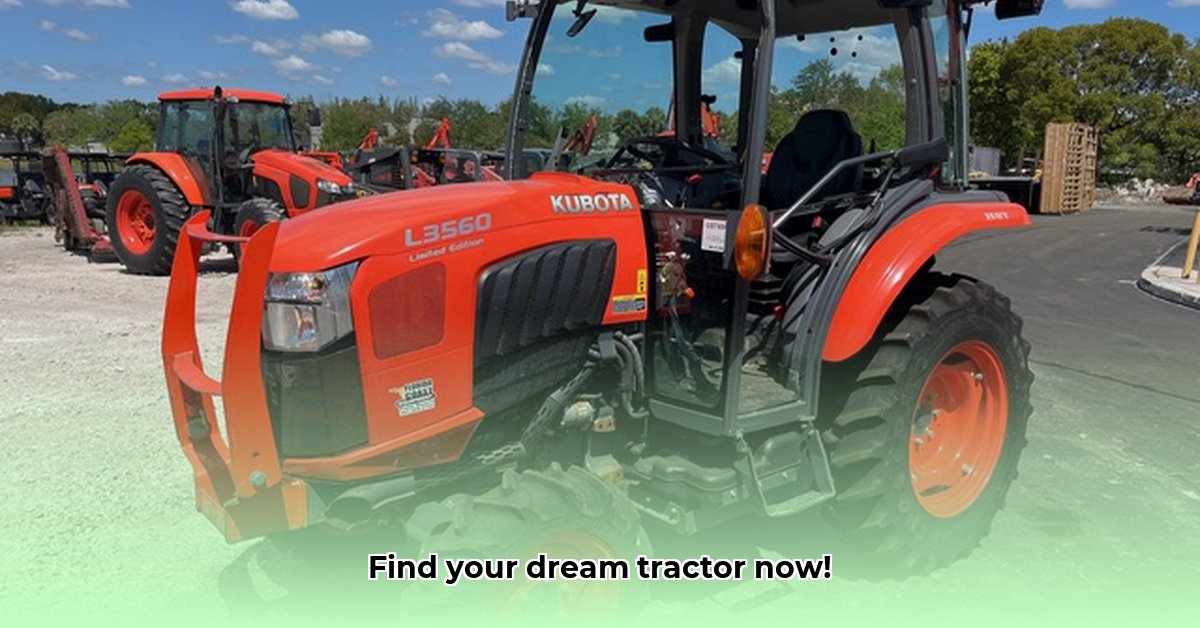
Understanding the Used Tractor Market in the US
The American market for used tractors is vast and varied, offering a wide range of brands, models, and price points. Finding the right tractor requires careful consideration of several key factors. This guide provides actionable steps to help you navigate this complex landscape and make an informed purchase.
Are you ready to invest in the right used tractor for your farm’s needs? The abundance of choices, from older, smaller tractors costing under $1000 to powerful, newer models exceeding $500,000, can be overwhelming. This guide simplifies the process, helping you avoid common pitfalls.
For even more tractor deals, check out these great offers. Kubota consistently ranks among the most popular brands, suggesting strong resale value. However, John Deere, Case IH, and New Holland are also significant players in this market.
Key Factors to Consider When Buying a Used Tractor
Investing in a used tractor is a significant financial commitment. To ensure a successful purchase, prioritize these factors:
Condition: A tractor's condition is paramount. Thorough inspection for wear and tear, including rust, dents, and tire tread depth, is crucial. Consider a professional inspection to uncover potential issues not readily apparent. While warranties exist, they might not cover all eventualities.
Brand and Model: Research different brands and models to determine the best fit for your budget and operational needs. A small-scale operator’s requirements will differ significantly from those of a large-scale farming operation.
Age and Hours: Newer tractors command higher prices, but older machines can offer excellent value. Operating hours are a reliable indicator of wear and tear; higher hours generally suggest increased wear, although proper maintenance significantly impacts longevity.
Location and Transportation: Proximity reduces transportation costs, but regional price variations should be considered. A cheaper tractor in a distant state might become more expensive after factoring in transport expenses.
"Prioritizing these factors helps eliminate many potential issues and ensures you get the tractor you actually need," advises Dr. Emily Carter, Agricultural Engineering Professor at Purdue University.
Where to Find Used Tractors: Online Marketplaces
Online marketplaces like IronPlanet and TractorHouse provide extensive inventories, facilitating price and model comparisons. However, exercise caution; online listings often lack the detail of an in-person inspection.
Advantages of Online Marketplaces:
- Vast selection of makes and models.
- Often competitive pricing.
- Convenient browsing from home.
Disadvantages of Online Marketplaces:
- Careful review of listings is essential; photos and descriptions can be misleading.
- A physical inspection remains crucial to assess true condition.
- Higher potential for scams; be wary of unusually attractive deals.
A Strategic Approach to Tractor Selection: The Scorecard Method
This structured approach helps you objectively compare different tractors:
Tractor Scorecard:
| Factor | Weight (Importance) | Rating (1-5) | Score |
|---|---|---|---|
| Condition | 40% | ||
| Brand/Model | 30% | ||
| Age/Hours | 20% | ||
| Price | 10% |
How to Use:
- Assign Weights: Reflect your priorities. Higher weight indicates greater importance.
- Rate Each Tractor: Assign a rating (1-5) for each factor.
- Calculate Scores: Multiply each rating by its weight and sum. The highest score indicates the most suitable tractor.
This system streamlines decision-making, though it doesn't eliminate the need for careful consideration.
Pre-Purchase Inspection: A Critical Step
Before finalizing any purchase, a comprehensive pre-purchase inspection is crucial. This involves a detailed visual inspection for signs of neglect or abuse, coupled with key fluid checks. Operational testing of the engine, PTO, hydraulics, three-point hitch, steering, and brakes is essential. Don't overlook a review of service records and maintenance logs. If you lack the expertise, consult a qualified mechanic.
Key Systems to Examine:
- Transmission: Smooth shifting is vital; difficulty shifting or slippage indicates potential issues.
- Hydraulics: Check for responsiveness, leaks, and slow response times.
- PTO: Verify proper function and RPM.
- Electrical System: Test all lights, gauges, and components.
“Never underestimate the value of a professional inspection,” emphasizes Mark Olsen, Certified Mechanic at Olsen’s Farm Equipment. "It could save you considerable expense in the long run.”
Long-Term Planning and Future Considerations
Remember that the used tractor market continuously evolves, with technological advances affecting the desirability of older models. Factor in potential obsolescence and plan for future upgrades to ensure your investment remains relevant.
By following these steps, you can confidently navigate the used tractor market and select a machine that meets your needs and contributes to your farming operation's success.